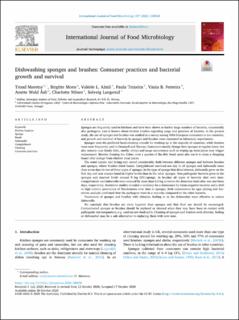| dc.description.abstract | Sponges are frequently used in kitchens and have been shown to harbor large numbers of bacteria, occasionally also pathogens. Less is known about kitchen brushes regarding usage and presence of bacteria. In the present study, the use of sponges and brushes was studied in a survey among 9966 European consumers in ten countries, and growth and survival of bacteria in sponges and brushes were examined in laboratory experiments. Sponges were the preferred hand-cleaning utensils for washing-up in the majority of countries, while brushes were most frequently used in Denmark and Norway. Consumers mostly change their sponges at regular times, but also sensory cues (looks dirty, smelly, slimy) and usage occurrences such as wiping up meat juices may trigger replacement. Besides cleaning the dishes, over a quarter of the dish brush users also use it to clean a chopping board after soilage from chicken meat juices. The water uptake and drying rate varied considerably, both between different sponges and between brushes and sponges, where brushes dried fastest. Campylobacter survived one day in all sponges and Salmonella more than seven days in two of three types of sponges. In the type of sponge that dried slowest, Salmonella grew on the first day and was always found in higher levels than in the other sponges. Non-pathogenic bacteria grew in the sponges and reached levels around 9 log CFU/sponge. In brushes all types of bacteria died over time. Campylobacter and Salmonella were reduced by more than 2.5 log to below the detection limit after one and three days, respectively. Bacteriota studies revealed a tendency for a dominance by Gram-negative bacteria and a shift to high relative prevalence of Pseudomonas over time in sponges. Both enumeration by agar plating and bacteriota analysis confirmed that the pathogens were in a minority compared to the other bacteria. Treatments of sponges and brushes with chlorine, boiling or in the dishwasher were effective to reduce Salmonella. We conclude that brushes are more hygienic than sponges and that their use should be encouraged. Contaminated sponges or brushes should be replaced or cleaned when they may have been in contact with pathogenic microorganisms, e.g. used on raw food spills. Cleaning of sponges and brushes with chlorine, boiling or dishwasher may be a safe alternative to replacing them with new ones. | |
